What Is Tropical Fruit Juice? Explained!
Tropical fruit juice is a delightful and nutritious beverage made from fruits cultivated in tropical regions.
It’s packed with essential vitamins, minerals, and antioxidants and is known for its bright colors and unique flavors.
Some popular varieties include mango, pineapple, papaya, and passion fruit juice. Tropical fruit juices are extracted from fruits that thrive in warm climates close to the equator.
These include, but are not limited to:
These juices are not only consumed for their taste but are also valued for their health-promoting properties.
They contain compounds that may boost the immune system, improve digestion, and support overall health. Experience the taste of the tropics with every sip of natural and vitamin-rich tropical fruit juice.
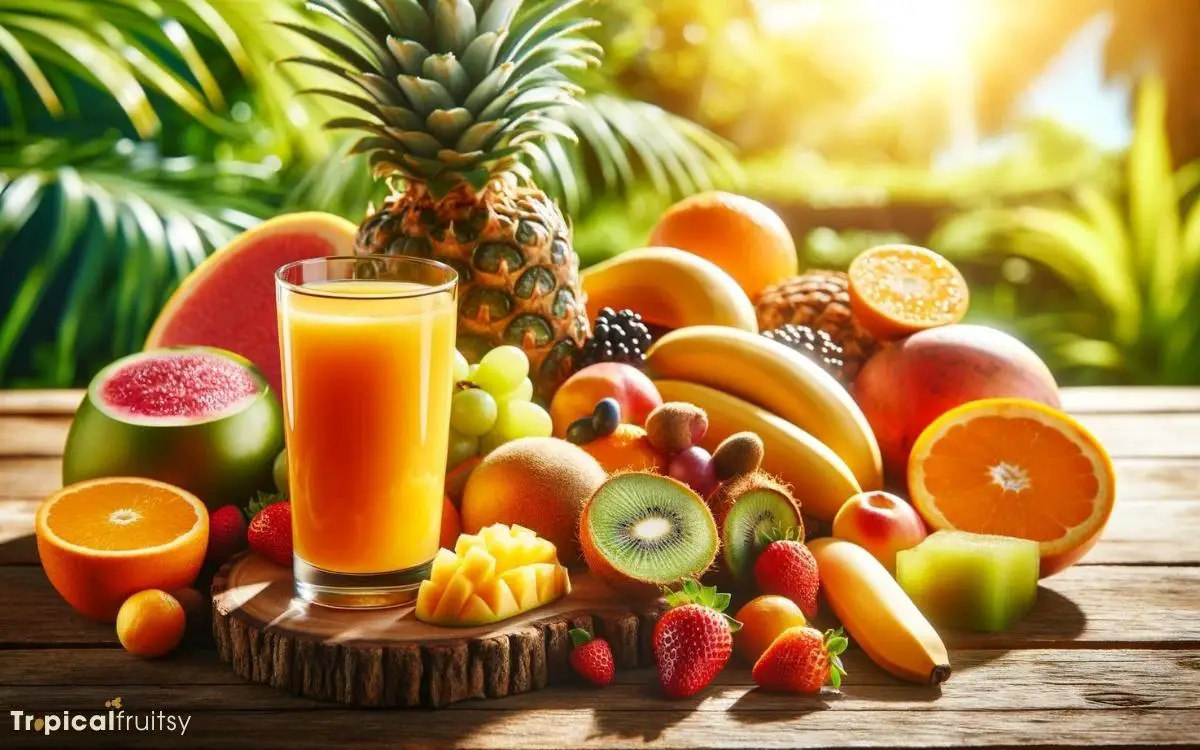
Key Takeaway
Tropical Fruits: Flavor Profiles and Nutritional Benefits
| Fruit Type | Flavor Profile | Nutritional Benefits |
|---|---|---|
| Mango | Sweet and rich | High in Vitamin C and A |
| Pineapple | Tart and sweet | Rich in Vitamin C and enzymes like bromelain |
| Papaya | Mild and sweet | Excellent source of Vitamin C and digestive enzymes |
| Passion Fruit | Tart with floral notes | Good source of fiber and Vitamin C |
| Guava | Sweet and tangy | High in Vitamin C, fiber, and antioxidants |
Defining Tropical Fruit Juice
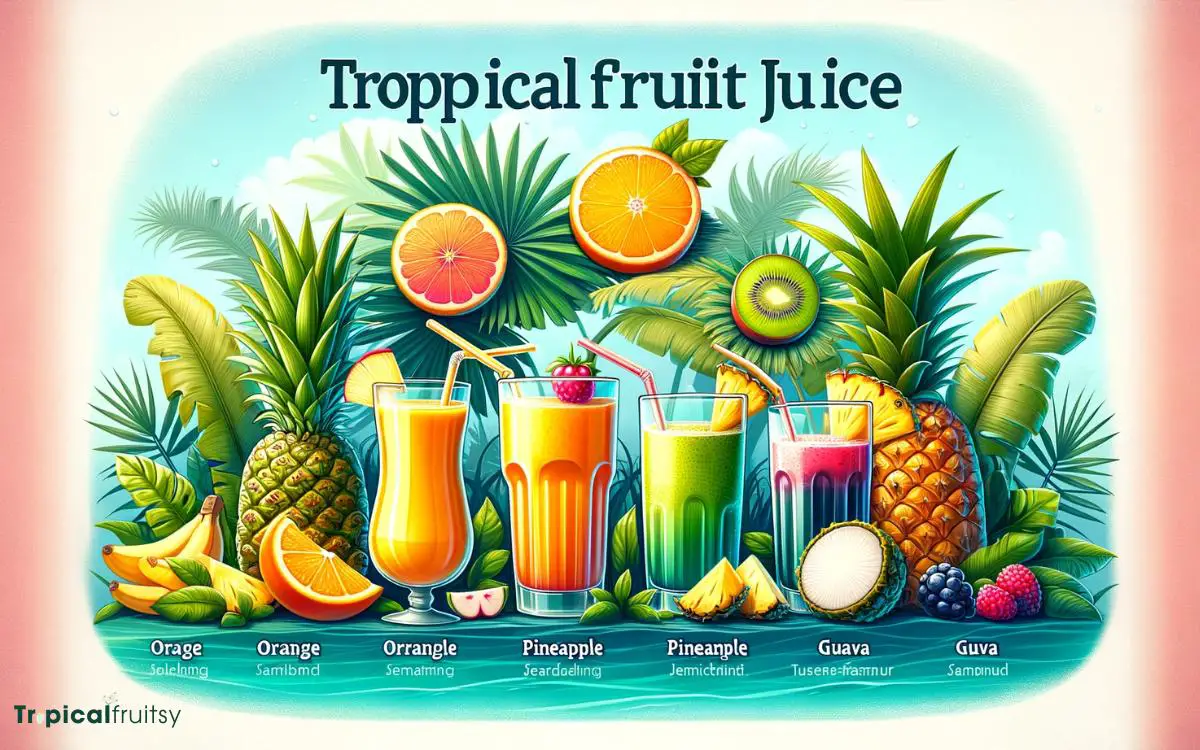
Tropical fruit juice is a beverage made from the liquid extracted from one or more types of tropical fruits. These fruits grow in regions situated between the Tropic of Cancer and the Tropic of Capricorn.
These regions are known for their warm climates, which are ideal for growing a diverse range of fruit species. Each fruit has its own unique flavor profile and nutritional composition.
The extraction process for tropical fruit juice typically involves mechanical or manual pressing. After pressing, the juice goes through a filtration process to remove any solids.
The resulting juice can be consumed as is, in its natural state. However, it can also undergo further processing, such as pasteurization, to extend its shelf life.
When it comes to producing high-quality and safe tropical fruit juice, the technical parameters are crucial. These include temperature control and enzymatic treatment.
Now, let’s delve into the history and origins of tropical fruit juice.
History and Origins
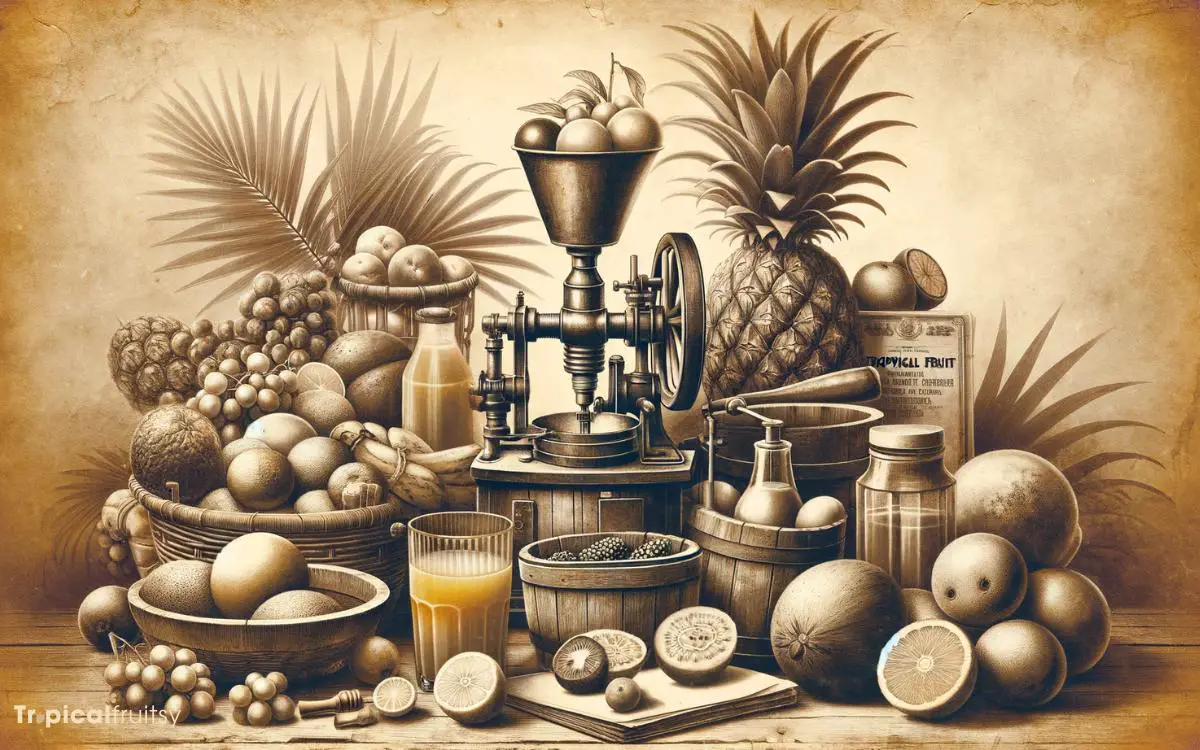
Historically, the consumption of tropical fruit juices has often been associated with the indigenous cultures of the regions where these fruits are natively found.
The origins of these juices can be traced back to ancient civilizations that utilized the natural bounty of their environment.
Tropical regions, blessed with a climate conducive to the growth of a wide variety of fruits, have long had practices of juice extraction for nutritional and medicinal purposes.
To illustrate the global dispersion and adoption of tropical fruit juices, consider the following table, which highlights the fruit and its region of origin:
| Fruit | Region of Origin |
|---|---|
| Mango | South Asia |
| Pineapple | South America |
| Papaya | Central America |
| Guava | Tropical America |
| Passion Fruit | Southern Brazil |
This table underscores the geographical diversity and historical roots of tropical fruits that contribute to the tapestry of modern juice consumption.
Common Tropical Fruits Used
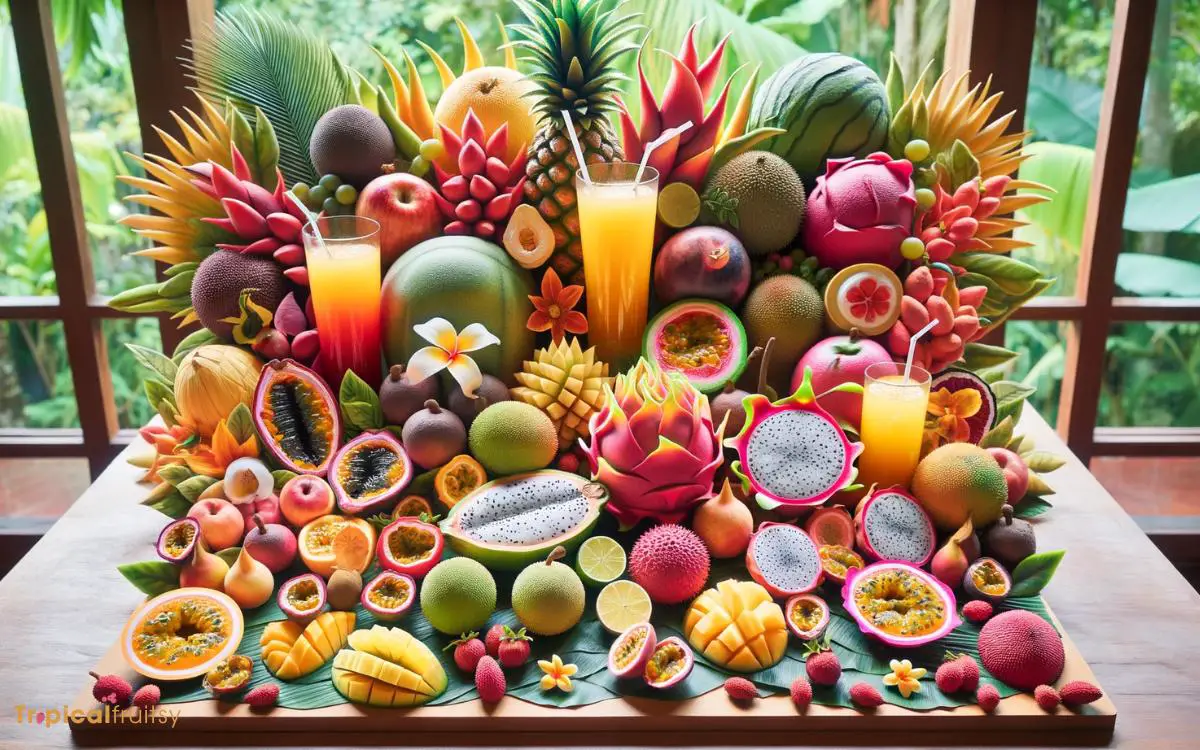
Commonly, juices are derived from fruits such as mangoes, pineapples, papayas, guavas, and passion fruits, which are integral to tropical regions’ dietary staples.
These fruits are not only lauded for their vibrant flavors but also for their rich nutritional profiles, which include vitamins, minerals, and antioxidants.
Mangoes, for instance, are a significant source of vitamin C and dietary fiber. Pineapples offer bromelain, an enzyme with anti-inflammatory properties, while papayas are noted for their papain enzyme, aiding digestion.
Guavas are densely packed with antioxidants and have a high vitamin C content. Passion fruits are distinctive for their high fiber content and phytochemicals.
Each fruit’s unique composition contributes to the multifaceted benefits of tropical fruit juices, making them a sought-after commodity in health-conscious markets.
Health Benefits Unveiled
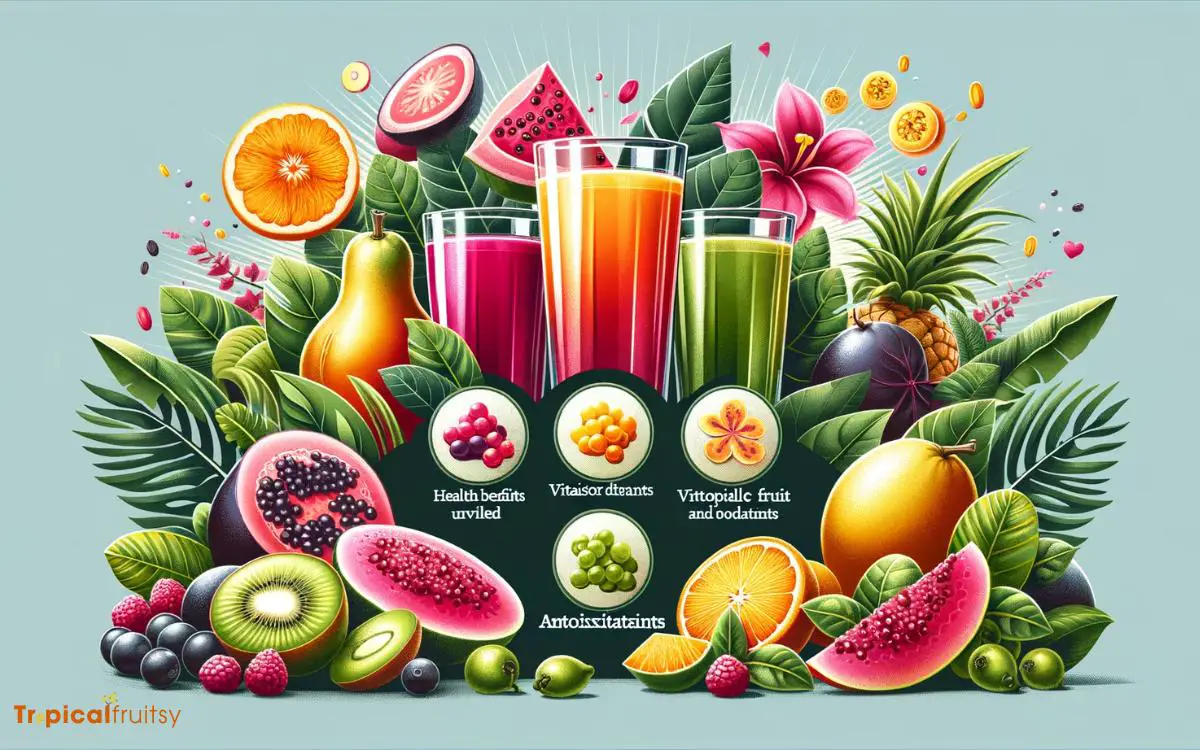
Why, then, are tropical fruit juices not only delightful to the palate but also beneficial to our health? The consumption of these vibrant beverages offers a multitude of health advantages, substantiated by nutritional science.
To elucidate:
Nutrient Density:
Tropical fruits are replete with essential vitamins, minerals, and antioxidants. Juices derived from these fruits deliver nutrients like vitamin C, potassium, and folate, which are pivotal for maintaining immune function, electrolyte balance, and cellular growth.
Antioxidant Capacity:
These juices contain compounds such as flavonoids and carotenoids. Such antioxidants are renowned for their ability to neutralize free radicals, thereby mitigating oxidative stress and potentially reducing the risk of chronic diseases.
Hydration and Digestive Aid:
Tropical fruit juices have a high water content and often contain dietary fiber, which promotes hydration and aids in digestion, contributing to overall gastrointestinal health.
Production and Processing

The production of tropical fruit juice involves a series of meticulous steps, from the selection of quality fruits to the application of advanced processing techniques, ensuring the preservation of the juice’s nutritional value and flavor.
The process typically commences with thorough washing, followed by sorting to exclude unsuitable fruits.
Extraction methods vary, with cold pressing and centrifugal juicing being prevalent for retaining maximum nutrients.
Pasteurization or ultra-high temperature (UHT) processing is applied to eliminate pathogens and extend shelf life, while careful packaging under aseptic conditions prevents contamination.
| Stage | Description |
|---|---|
| Selection | Handpicked, ripe, and defect-free tropical fruits. |
| Cleaning | Rigorous washing to remove impurities. |
| Extraction | Employing cold press/centrifugal methods. |
| Sterilization | Pasteurization/UHT for safety and longevity. |
| Packaging | Aseptic filling to maintain quality. |
As we delve into the subsequent section, we shall explore the complexities of flavor profiles inherent in tropical fruit juices.
Flavor Profiles Explored

Exploring the flavor profiles of tropical fruit juices, sweetness variations emerge as a critical factor influencing consumer preferences and product differentiation.
Acid balance plays a pivotal role in the overall sensory experience, affecting both the palatability and perceived freshness of the juice.
These attributes are quantifiable through analytical techniques, which can be correlated to both fruit origin and processing methodologies.
Sweetness Variations
Within the realm of tropical fruit juices, sweetness levels can vary significantly, reflecting the diverse flavor profiles of the constituent fruits.
This variation is attributable to the natural sugars present, which differ not only between species but also due to factors like ripeness and cultivation methods.
To illustrate:
- Mango Juice: Typically high in sweetness, mangoes contain sucrose, glucose, and fructose, which combine to give a rich, sugary profile.
- Pineapple Juice: While also sweet, pineapple has lower sucrose levels and a more complex flavor due to additional organic acids.
- Passion Fruit Juice: Often less sweet and more tart, passion fruit’s unique flavor is a result of lower sugar content and higher citric acid levels.
This exploration of sweetness sets the stage for understanding the critical role of acidity balance in tropical fruit juices.
Acidity Balance
In tropical fruit juices, the balance of acidity is as crucial as sweetness for defining the beverage’s overall flavor profile.
Acidity, typically measured in terms of pH levels and titratable acidity, contributes to the tartness and sharpness that can enhance or overpower the inherent sweetness of the juice.
The technical interplay between organic acids such as citric, malic, and ascorbic acid dictates not only the sensory perception but also the stability and preservation qualities of the juice.
An analytical approach to crafting tropical fruit juice involves precise adjustments of these acid concentrations to achieve a harmonious flavor profile.
This meticulous process ensures a palatable balance that appeals to the consumer’s taste preferences while maintaining the product’s quality and shelf-life.
Mixing and Pairing Ideas
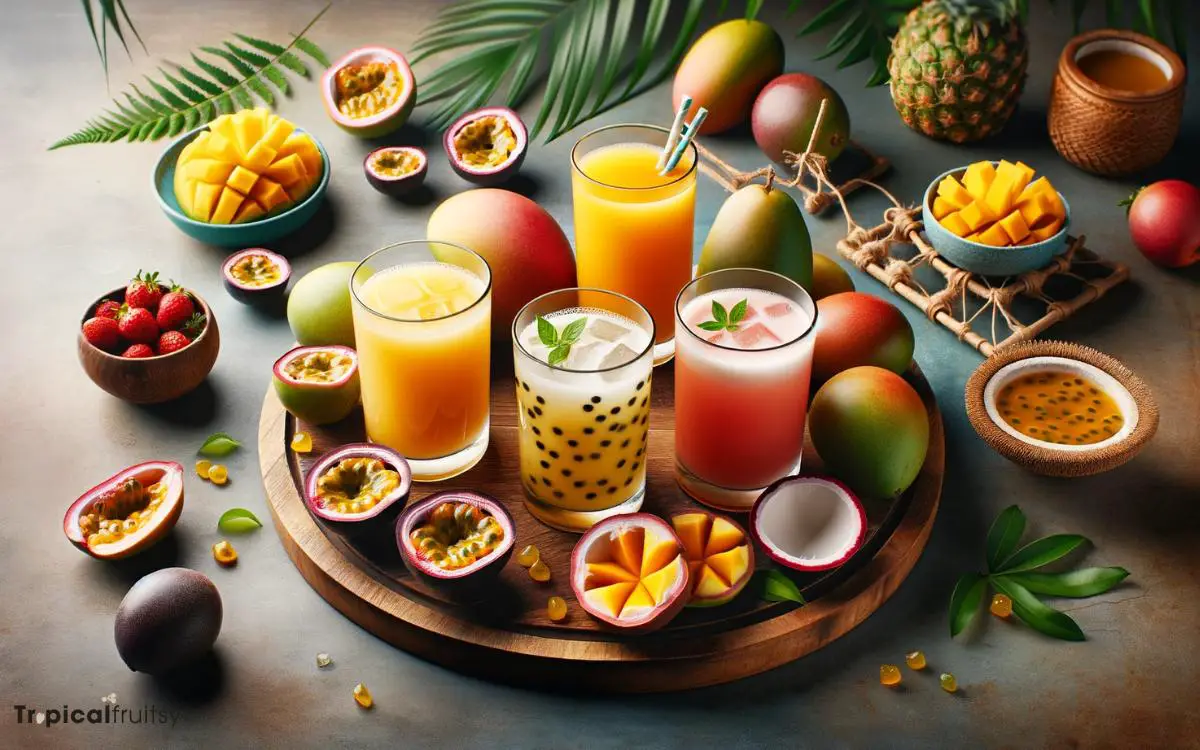
In considering the intricacies of tropical fruit juice mixology, one must evaluate optimal flavor combinations that enhance the sensory experience.
The judicious balance of sweetness and acidity is crucial to achieving a harmonious blend that appeals to the palate.
Moreover, the integration of these juices into cocktails offers an avenue for creative expression, necessitating a comprehensive understanding of ingredient compatibility and mixology techniques.
Flavor Combinations
Exploring the wide array of flavor combinations in tropical fruit juices can enhance both their nutritional value and taste appeal.
When formulating juice blends, it is crucial to consider the compatibility of flavor profiles and the potential for nutrient synergies.
Here are some scientifically grounded pairing ideas:
- Pineapple and Mango: This combination offers a balance of enzymes such as bromelain from pineapple, which aids in digestion, and the lush sweetness of mango, which is rich in vitamins A and C.
- Guava and Papaya: Guava’s high vitamin C content complements papaya’s papain enzyme, promoting a blend that can support immune function and digestive health.
- Passion Fruit and Lime: The tartness of passion fruit pairs well with the zesty flavor of lime, creating a sensory profile that is not only refreshing but also provides an abundance of antioxidants and enhances iron absorption.
Balance Sweetness/Acidity
Following the exploration of flavor combinations, achieving the optimal balance of sweetness and acidity is pivotal when mixing and pairing tropical fruits to create a harmonious juice profile.
This balance is critical, as it affects the palatability and overall sensory appeal of the juice. A technical approach requires precise measurement of the Brix (sugar content) and titratable acidity.
Fruits with high Brix values, such as mangoes and pineapples, provide robust sweetness, which can be counterbalanced by the sharp acidity from citrus fruits like lime or passion fruit.
Methodically adjusting the ratios of these components ensures a juice that delivers a refreshing taste experience while maintaining the integrity of the individual fruit characteristics.
Careful consideration of these factors results in a consummate tropical fruit juice, appealing to those with discerning tastes.
Cocktail Inspirations
With the foundation of balance between sweetness and acidity established, tropical fruit juices become an exquisite base for innovative cocktail creations, offering mixologists a vibrant palette for crafting refreshing and exotic drinks.
The following list delineates a trio of mixological principles that guide the incorporation of tropical fruit juices into cocktail recipes:
- Complementarity: Select spirits that complement the dominant flavor profiles of the tropical juice, such as pairing mango juice with tequila or pineapple juice with rum.
- Contrast: Employ ingredients that offer a contrasting note, like adding a spicy ginger element to a sweet passion fruit concoction.
- Complexity: Layer flavors using modifiers such as liqueurs, bitters, and fresh herbs to add depth and complexity to the primary tropical juice component.
These principles enable a structured yet creative approach to tropical cocktail mixology, ensuring a harmonious blend of ingredients that cater to discerning palates.
What Are Some Common Tropical Fruits Used in Making Tropical Fruit Juice?
Some common tropical fruits used in making tropical fruit juice include pineapple, mango, papaya, guava, and passion fruit. Each of these fruits has a distinct tropical fruit meaning explained by their sweet and refreshing flavors, making them popular choices for creating delicious tropical fruit juices.
Global Popularity and Trends

Tropical fruit juice has experienced a surge in demand across the globe due to its perceived health benefits and exotic flavor profiles.
This uptick aligns with consumer trends emphasizing wellness and a preference for natural products.
Market analysis reveals an increasing inclination towards juices derived from fruits like mango, papaya, and passionfruit, which are rich in vitamins and antioxidants.
The diversification of juice offerings, coupled with innovative packaging and branding strategies, has facilitated entry into new demographic segments.
The integration of tropical flavors in functional beverages – those fortified with added nutrients or herbal extracts – is expanding market reach.
As health-conscious consumers seek out products with added value, tropical fruit juices are increasingly positioned as both indulgent and beneficial, driving their global popularity.
Conclusion
Tropical fruit juice represents a vibrant segment of the beverage industry, renowned for its diverse flavor profiles and nutritional benefits.
As a rich source of vitamins, antioxidants, and essential minerals, these juices not only tantalize the taste buds but also contribute to overall health.
A notable statistic is that the global fruit and vegetable juice market, with tropical juices as a key component, is projected to reach approximately $173 billion by 2024, reflecting their rising global appeal and demand.






